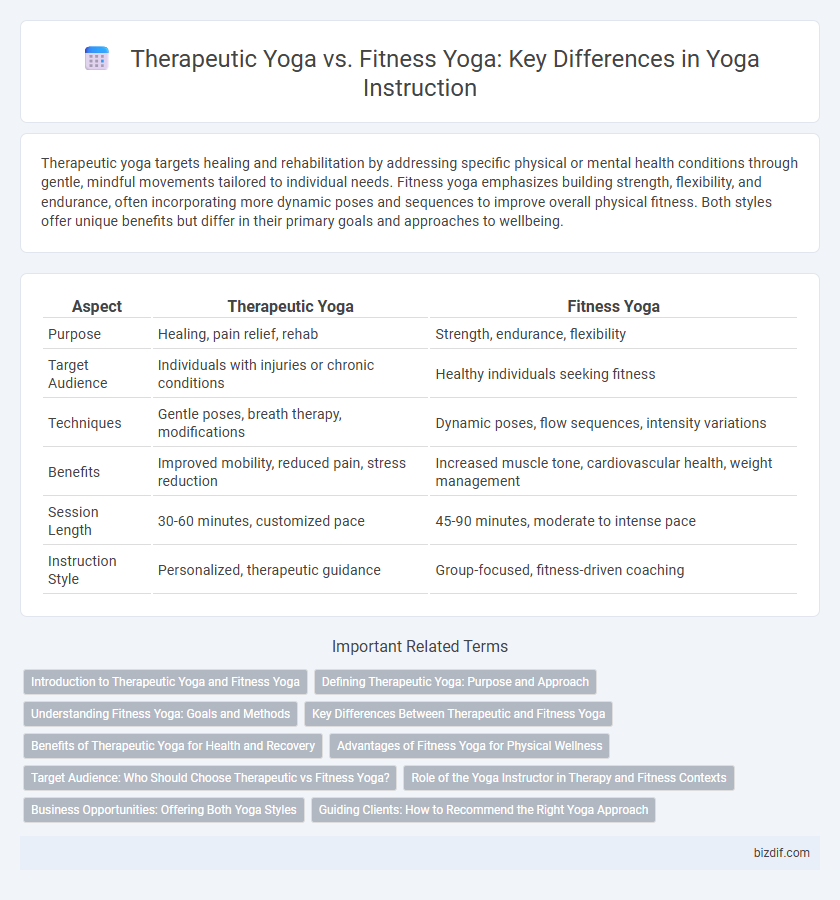Therapeutic yoga targets healing and rehabilitation by addressing specific physical or mental health conditions through gentle, mindful movements tailored to individual needs. Fitness yoga emphasizes building strength, flexibility, and endurance, often incorporating more dynamic poses and sequences to improve overall physical fitness. Both styles offer unique benefits but differ in their primary goals and approaches to wellbeing.
Table of Comparison
| Aspect | Therapeutic Yoga | Fitness Yoga |
|---|---|---|
| Purpose | Healing, pain relief, rehab | Strength, endurance, flexibility |
| Target Audience | Individuals with injuries or chronic conditions | Healthy individuals seeking fitness |
| Techniques | Gentle poses, breath therapy, modifications | Dynamic poses, flow sequences, intensity variations |
| Benefits | Improved mobility, reduced pain, stress reduction | Increased muscle tone, cardiovascular health, weight management |
| Session Length | 30-60 minutes, customized pace | 45-90 minutes, moderate to intense pace |
| Instruction Style | Personalized, therapeutic guidance | Group-focused, fitness-driven coaching |
Introduction to Therapeutic Yoga and Fitness Yoga
Therapeutic Yoga targets specific health conditions by combining gentle poses, breathwork, and mindfulness to promote physical healing and mental well-being. Fitness Yoga emphasizes strength, flexibility, and endurance through dynamic sequences and more vigorous postures, enhancing overall physical fitness. Both styles incorporate foundational yoga principles but cater to distinct goals: therapeutic for rehabilitation and fitness for athletic performance.
Defining Therapeutic Yoga: Purpose and Approach
Therapeutic Yoga is a specialized practice designed to address specific health conditions, emphasizing injury prevention, pain relief, and physical rehabilitation through personalized and adaptive techniques. It integrates breathwork, mindfulness, and gentle movement tailored to individual needs, promoting holistic healing and improved functionality. Unlike general Fitness Yoga, which focuses on strength, flexibility, and endurance, Therapeutic Yoga prioritizes restoring balance and supporting recovery under the guidance of trained professionals.
Understanding Fitness Yoga: Goals and Methods
Fitness yoga emphasizes improving physical strength, flexibility, and endurance through dynamic poses and sequences tailored for cardiovascular health and muscle toning. Its methods often incorporate vigorous flows such as Vinyasa or Power Yoga, designed to boost metabolism and enhance overall fitness levels. The primary goal of fitness yoga is to promote a balanced, healthy body by integrating traditional yoga postures with modern exercise principles.
Key Differences Between Therapeutic and Fitness Yoga
Therapeutic yoga emphasizes healing and rehabilitation, targeting specific physical or mental health conditions through gentle, adaptive poses and mindfulness techniques. Fitness yoga focuses on building strength, flexibility, and endurance with dynamic sequences such as Vinyasa or Power Yoga designed for overall physical fitness. Key differences include the intention behind practice, the pace and intensity of sessions, and the customization based on individual health needs versus general fitness goals.
Benefits of Therapeutic Yoga for Health and Recovery
Therapeutic yoga offers targeted benefits for health and recovery by focusing on gentle movements, breath control, and mindfulness to alleviate chronic pain, improve flexibility, and reduce stress-related symptoms. This approach supports rehabilitation from injuries and medical conditions such as arthritis, back pain, and anxiety, promoting overall healing and mental clarity. Unlike fitness yoga, which emphasizes physical conditioning and strength, therapeutic yoga prioritizes individual health needs and gradual progress tailored to specific therapeutic goals.
Advantages of Fitness Yoga for Physical Wellness
Fitness Yoga enhances cardiovascular health by incorporating dynamic sequences like Vinyasa and Power Yoga that increase heart rate and stamina. It improves muscular strength and flexibility through sustained postures and flows, reducing the risk of injury and promoting better body alignment. Regular practice supports weight management and boosts metabolism, contributing significantly to overall physical wellness.
Target Audience: Who Should Choose Therapeutic vs Fitness Yoga?
Therapeutic Yoga is ideal for individuals recovering from injury, managing chronic pain, or seeking gentle, restorative practices tailored to medical conditions. Fitness Yoga suits active practitioners aiming to improve strength, flexibility, and cardiovascular health through dynamic sequences like Vinyasa or Power Yoga. Selecting between Therapeutic and Fitness Yoga depends on personal health goals, physical limitations, and desired intensity level.
Role of the Yoga Instructor in Therapy and Fitness Contexts
Yoga instructors in therapeutic settings tailor practices to address specific physical or mental health issues, emphasizing healing and rehabilitation through personalized guidance and modifications. In fitness yoga, instructors prioritize enhancing strength, flexibility, and endurance, often leading dynamic and standardized sessions with a focus on physical performance. The instructor's role varies significantly, requiring specialized knowledge in anatomy and pathology for therapy, while fitness contexts demand expertise in exercise physiology and motivation techniques.
Business Opportunities: Offering Both Yoga Styles
Offering both Therapeutic Yoga and Fitness Yoga creates diverse business opportunities by attracting a broader client base seeking either injury rehabilitation or physical conditioning. Integrating these styles enhances market reach, allowing studios to cater to wellness-focused individuals and fitness enthusiasts simultaneously. This dual approach increases revenue streams through specialized classes, workshops, and personalized programs tailored to distinct health and fitness goals.
Guiding Clients: How to Recommend the Right Yoga Approach
Therapeutic Yoga emphasizes injury prevention, pain relief, and chronic condition management through personalized poses and breathwork, making it ideal for clients with medical concerns or rehabilitation needs. Fitness Yoga targets strength, flexibility, and cardiovascular health with dynamic sequences suitable for clients aiming to improve overall physical fitness and stamina. Assessing client goals, health history, and physical limitations ensures instructors recommend either Therapeutic or Fitness Yoga approaches that best support individual well-being and progress.
Therapeutic Yoga vs Fitness Yoga Infographic

 bizdif.com
bizdif.com